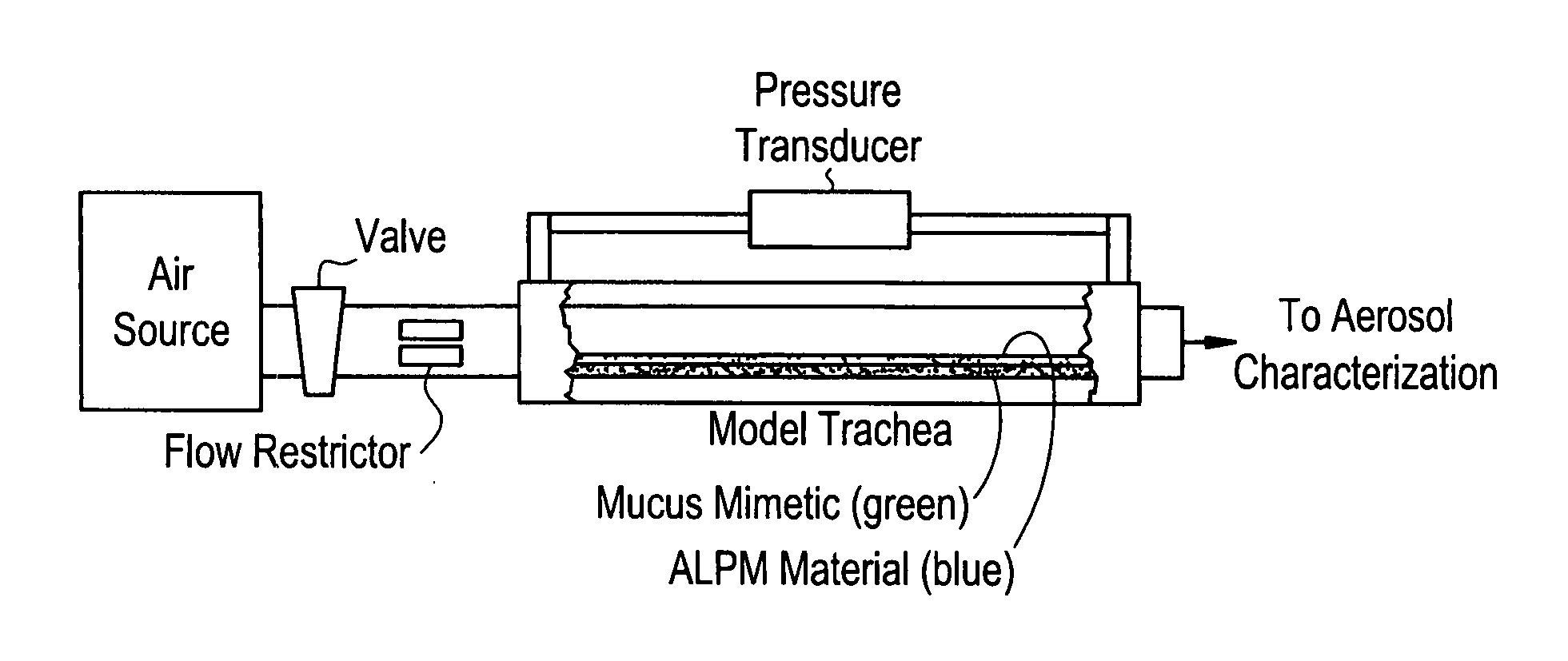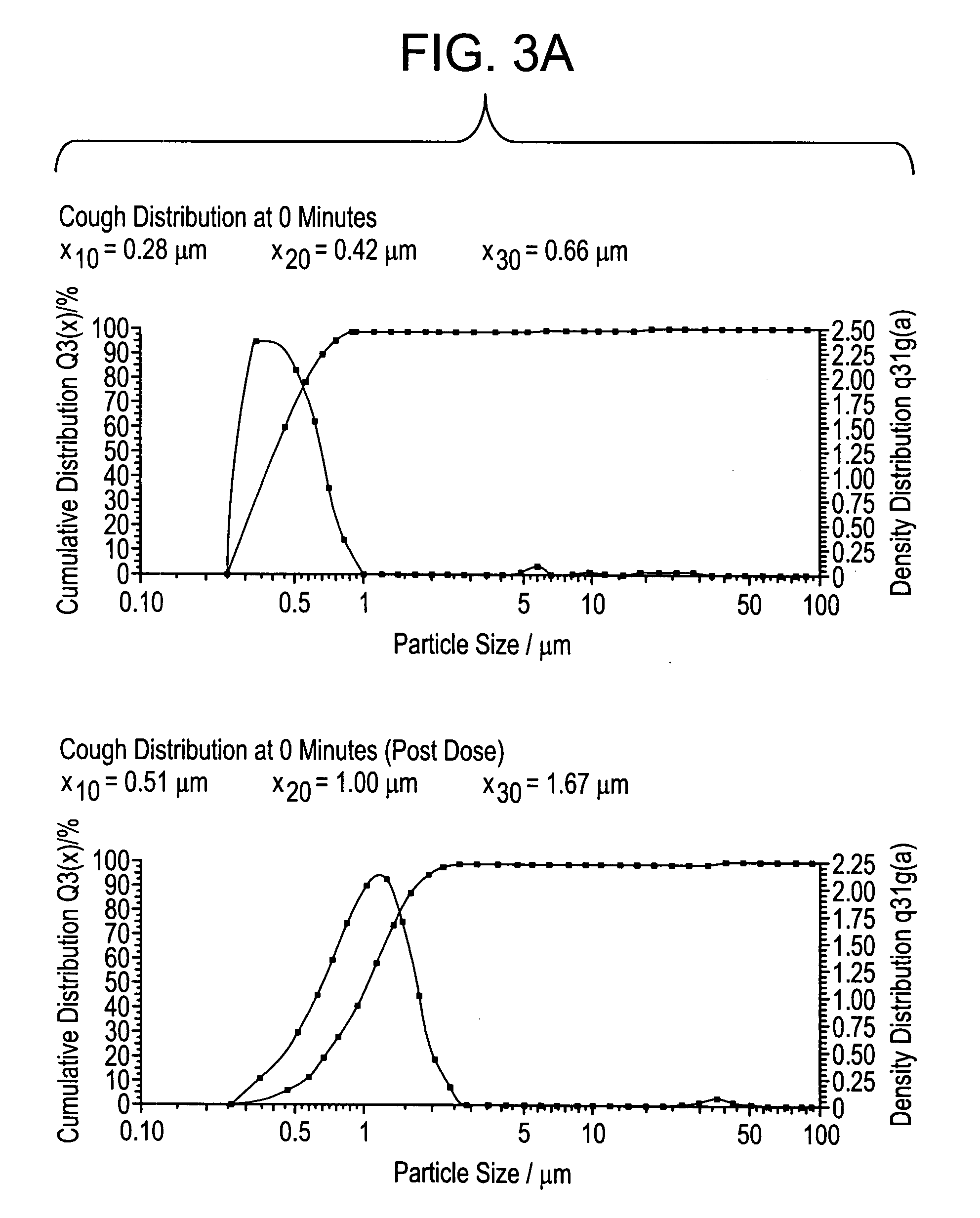Formulations decreasing particle exhalation
a technology of exhalation and particle, applied in the field of formulations and systems, can solve the problems of high mortality rate of elderly and immunocompromised populations, high prevalence of viral and bacterial infections, epidemic proportions, etc., and achieve the effects of reducing the infectivity of diseases, reducing or preventing the exhalation of particulate matter, and reducing surface instabilities
- Summary
- Abstract
- Description
- Claims
- Application Information
AI Technical Summary
Benefits of technology
Problems solved by technology
Method used
Image
Examples
example 1
[0074] As shown in FIG. 1, a simulated cough machine system was designed similar to that described by King Am. J. Respir. Crit. Care Med. 156(1):173-7 (1997). An air-tight 6.25-liter Plexiglas tank equipped with a digital pressure gauge and pressure relief valve was constructed to serve as the capacitance function of the lungs. To pressurize the tank, a grade dry compressed air cylinder with regulator was connected to the inlet. At the outlet of the tank, an Asco two-way normally-closed solenoid valve (8210G94) with a sufficient Cv flow factor was connected for gas release. The solenoid valve was wired using a typical 120V, 60 Hz light switch. Connected to the outflow of the solenoid valve was a Fleisch no. 4 pneumotachograph, which created a Poiseuille flow needed to examine the “cough” profile. The outlet of the Fleisch tube was connected to a ¼ NPT entrance to our model trachea. A Validyne DP45-14 differential pressure transducer measured the pressure drop thr...
example 2
Reduction of Exhaled Aerosol Particles in Human Study
[0079] A proof of concept study of exhaled aerosol particle production was performed using 12 healthy subjects. The objectives of the study were (1) to determine the nature of exhaled bioaerosol particles (size distribution and number); (2) to validate the utility of a device that is sensitive enough to accurately count the exhaled particles; (3) to assess the baseline count of particles exhaled from the healthy lung; and (4) to measure the effect of two exogenously administered treatment aerosols on exhaled particle count suppression. Experiments were performed with different particle detectors to determine average particles per liter and average particle size for healthy human subjects. Following the inspiration of particle-free air, healthy subjects breathe out as little as 1-5 particles per liter, with an average size of 200-400 nm in diameter. Significant variations occur in numbers of particles from subject to subject, so t...
example 3
Large Animal Study
[0085] Seven (7) Holstein bull calves were anesthetized, intubated, and screened for baseline particle exhalation by optical laser counting. Animals were subsequently untreated (sham) or treated with a nebulized aerosol of saline at one of three doses (1.8 minutes, 6.0 minutes or 12.0 minutes). During the sham dosage, the animals were handled in the same manner as they were when the dosages of the isotonic saline solution were administered. One animal was dosed per day and nebulizer doses were randomized throughout the exposure period (see Table 1 for dosing schedule). Each animal was slated to receive all doses during the duration of the study. Following the administration of each dose, exhaled particle counts were monitored at discrete timepoints (0, 15, 30, 45, 60, 90, 120) through 180 minutes.
[0086] The exposure matrix for the animals included in the study is found in Table 1. The dosing occurred over a 57 day period, with at least a 7 day interval between do...
PUM
| Property | Measurement | Unit |
|---|---|---|
| diameter | aaaaa | aaaaa |
| diameter | aaaaa | aaaaa |
| thickness | aaaaa | aaaaa |
Abstract
Description
Claims
Application Information
 Login to View More
Login to View More - R&D
- Intellectual Property
- Life Sciences
- Materials
- Tech Scout
- Unparalleled Data Quality
- Higher Quality Content
- 60% Fewer Hallucinations
Browse by: Latest US Patents, China's latest patents, Technical Efficacy Thesaurus, Application Domain, Technology Topic, Popular Technical Reports.
© 2025 PatSnap. All rights reserved.Legal|Privacy policy|Modern Slavery Act Transparency Statement|Sitemap|About US| Contact US: help@patsnap.com



